The AMD Radeon R9 Nano Review: The Power of Size
by Ryan Smith on September 10, 2015 8:00 AM ESTGrand Theft Auto V
The latest edition of Rockstar’s venerable series of open world action games, Grand Theft Auto V was originally released to the last-gen consoles back in 2013. However thanks to a rather significant facelift for the current-gen consoles and PCs, along with the ability to greatly turn up rendering distances and add other features like MSAA and more realistic shadows, the end result is a game that is still among the most stressful of our benchmarks when all of its features are turned up. Furthermore, in a move rather uncharacteristic of most open world action games, Grand Theft Auto also includes a very comprehensive benchmark mode, giving us a great chance to look into the performance of an open world action game.
On a quick note about settings, as Grand Theft Auto V doesn't have pre-defined settings tiers, I want to quickly note what settings we're using. For "Very High" quality we have all of the primary graphics settings turned up to their highest setting, with the exception of grass, which is at its own very high setting. Meanwhile 4x MSAA is enabled for direct views and reflections. This setting also involves turning on some of the advanced redering features - the game's long shadows, high resolution shadows, and high definition flight streaming - but not increasing the view distance any further.
Otherwise for "High" quality we take the same basic settings but turn off all MSAA, which significantly reduces the GPU rendering and VRAM requirements.
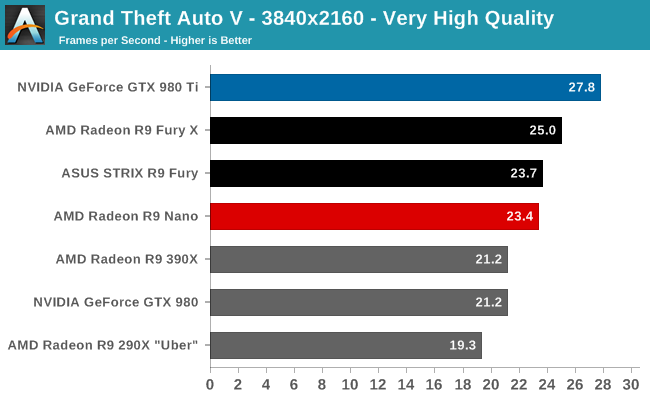
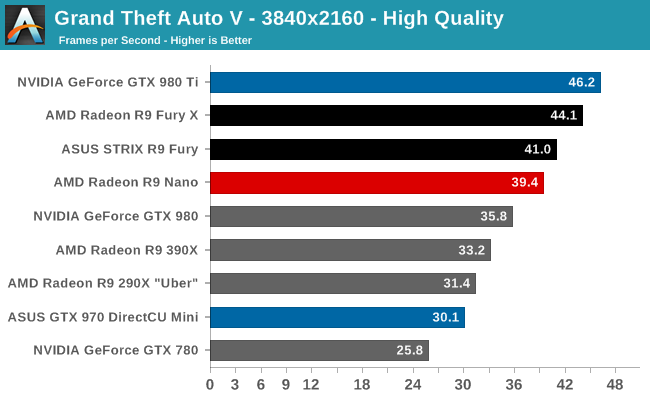
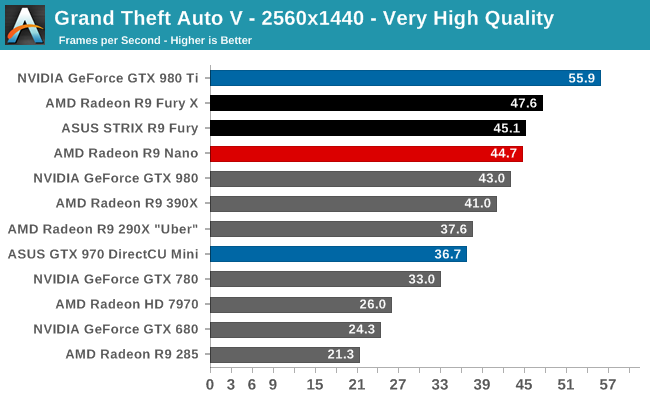
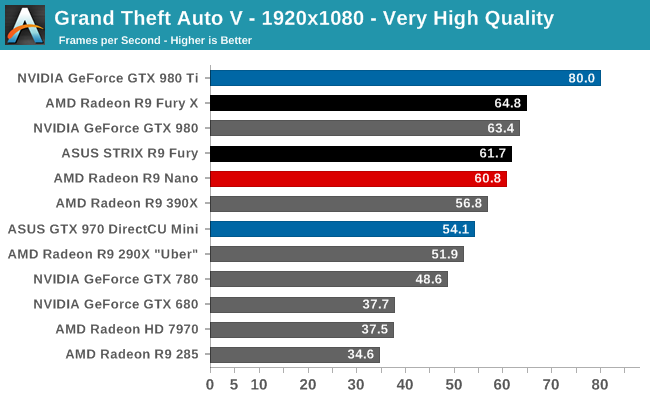
Closing things out with one of our most strenuous games, we have a mixed bag for the R9 Nano. Performance relative to the R9 Fury X and R9 Fury is ending on a high note, with the R9 Nano trailing the other Fiji cards by around 10% and 4% respectively. The R9 Nano continues to impress in its ability to deliver performance so close to the R9 Fury, and games like GTA V are prime examples of this.
The catch for AMD here is that on an absolute basis, GTA really forces you to either compromise on quality or resolution if you want to hit 60fps. In this case we’d need to drop all the way to 1920x1080 for 60fps on the Nano, and this eats away at AMD’s intrinsic advantage over NVIDIA where AMD’s performance drops off more slowly with higher resolutions. As a result the power-similar GTX 980 is close in performance to the R9 Nano at 2560x1440 and takes a small lead at 1920x1080.
Otherwise AMD at least looks solid on a size-wise comparison. The R9 Nano holds a comfortable lead over the GTX 970 Mini, ranging from 12% at 1920x1080 up to 31% at 3840x2160 high quality.
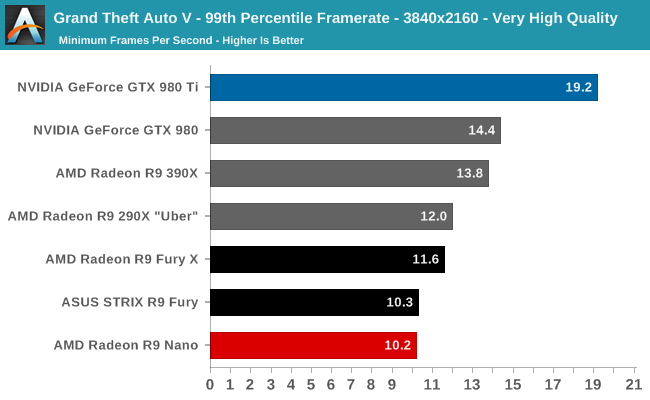
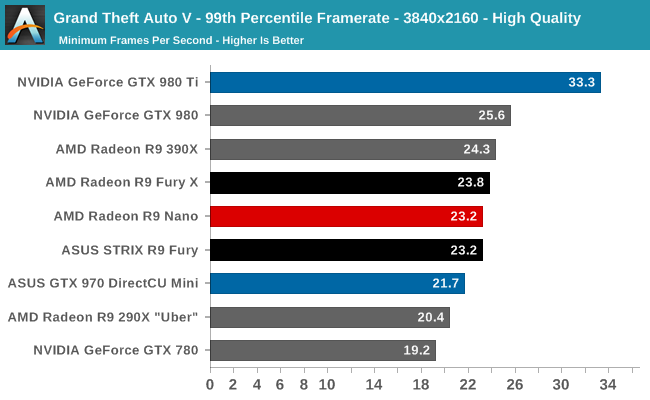
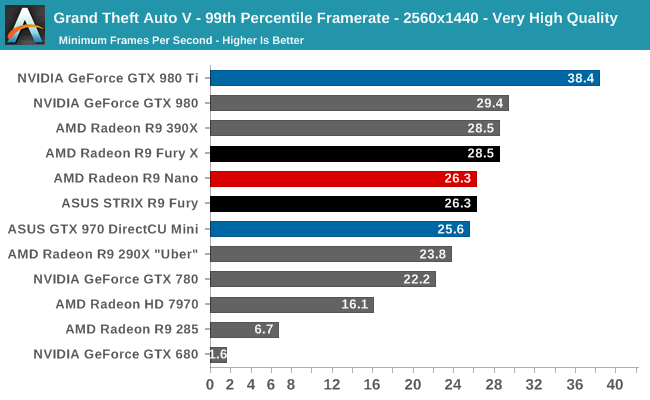
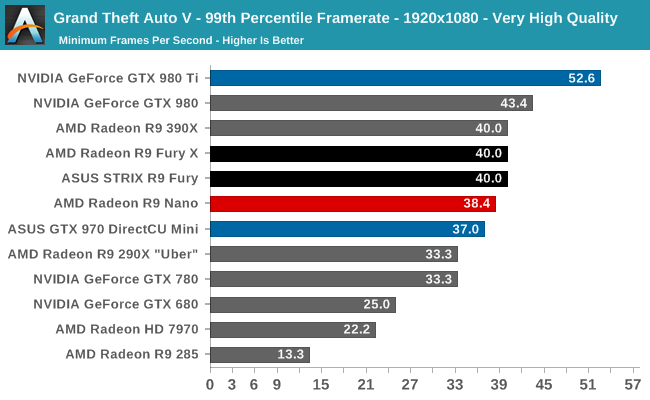
99th percentile framerates however are simply not in AMD’s favor here. Despite the fact that the GTX 980 only has 4GB of VRAM as well, the R9 Nano simply can’t catch up to the GTX 980.










284 Comments
View All Comments
gw74 - Friday, September 11, 2015 - link
Everything you say here is refuted by my previous comment.slickr - Saturday, September 12, 2015 - link
LOL. Either you are one of the biggest dumbasses out there or a shill yourself. To believe it was a "honest mistake" is like believing the earth is made out of cheese.They had at least 2 months to fix it and to rectify it, did they not read any of the hundred of reviews? They tried to cover it up and it was only when average CONSUMERS started noticing it and testing it that it was found out it had been a major fraud.
gw74 - Saturday, September 12, 2015 - link
insulting me, setting up a false dichotomy and a false analogy will not help you.They did not realise there had been an error during those 2 months, and none of the reviews mentioned it, because it does not noticeably affect performance except in certain SLI / 4K low framerate edge cases. It was only when until users starting reporting it in mid Jan. They had meetings between marketing and engineering then released a statement to PCPer on 24th Jan.
Oxford Guy - Tuesday, September 15, 2015 - link
Nvidia continued to lie to the public on its website by stating that the 970 has 224 GB/s, long after Anandtech's Correcting the Specs article was published — which made it clear enough that the card can't reach that number. Quit shilling.Alexvrb - Saturday, September 12, 2015 - link
Err, uh, the engineers only communicate in binary! The translator was sick that week! Locusts! It wasn't their fault!!Reality: "Well technically it has 4GB on there so we'll just... leave that detail out... they won't notice for months anyway. Then we'll apologize and a bunch of fanboys will defend us till the bitter end anyway."
If AMD had pulled a stunt like that they would have been raked through the coals till there were only ashes.
gw74 - Saturday, September 12, 2015 - link
no. that is not "reality". That is speculation.bigboxes - Thursday, September 10, 2015 - link
Utter nonsense. Nvidia knew damn well that they had a technical and marketing issue and lied through their teeth. Misleading reviewers, customers and the general tech community. It eventually came out and they went into full damage control. And before you say it, I bought an MSI GTX 970 Gaming 4G card after all this went down. I'm happy with this card, but it is what it is.gw74 - Friday, September 11, 2015 - link
you forgot to include evidence of them lying, or a reason for why they would lie.Oxford Guy - Friday, September 11, 2015 - link
It's called reality, dude.gw74 - Friday, September 11, 2015 - link
meaningless